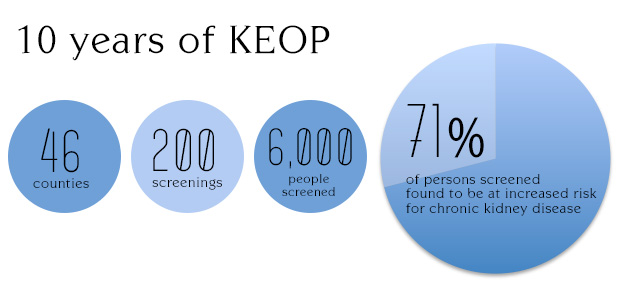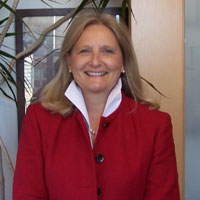UNC’s Kidney Education Outreach Program (KEOP) is celebrating 10 years of kidney screenings in the communities of North Carolina. The very first screening took place in October of 2005, and since then, more than 6,000 people at increased risk for CKD in North Carolina have had their kidney function screened as a result of this program.


The KEOP establishes partnerships with communities that are considered high-risk populations for developing chronic kidney disease (CKD). KEOP has nurtured relationships with 46 counties in North Carolina through screenings and community-based conversations where the risk factors of CKD are discussed and participants are encouraged to remember to ask, “Hey Doc, How are My Kidneys?”®
Donna Harward, the Director of Outreach and Education for the UNC Kidney Center, has been leading these efforts. In the following interview, Ms. Harward discusses this outreach program and shares some insights about what has taken place over the last 10 years.
How have the community partnerships been developed?
KEOP community partnerships are established using the Principles of Community Engagement Guidelines (Center of Disease Control and Prevention). In addition, KEOP target counties, those counties with highest prevalence rates of end-stage kidney disease, benefit from media campaigns (billboards and/or television public service advertisements) using local spokespersons to promote CKD awareness. Meetings with county health directors and formal presentations to county commissioners are the initial points of contact followed by visits with local clergy, lay leaders, civic clubs, business owners and interested residents. From these encounters, a list of potential hosts for community kidney health conversations and screening events is generated.
In non-target counties, an organization or individual contacts the KEOP to inquire about a kidney screening and/or a community conversation. Frequently, these inquiries are from persons who have learned about the KEOP from colleagues, family or friends in other communities. In all KEOP community partnerships, individuals who coordinate the event become informed about ways to maintain kidney health and understand the role of kidney replacement therapy, and are, therefore, essential to promoting and sustaining the KEOP’s message in their respective communities.
When did the targeted screenings start?
Targeted screenings have been a key ingredient in the KEOP’s program since its inception in the fall of 2005. Our promotional materials and community conversations focus on CKD risk factors so that persons can make informed choices about being screened; we will screen anyone 18 years of age or older who can provide a urine specimen. In addition, we distribute our Get Tested!, a self-assessment tool that explains the 3 most common methods of assessing kidney health and contains the SCORED (Screening for Occult REnal Disease) CKD prediction model. Our mobile unit, outfitted with an examination room and small laboratory space, and two lavatories, and two generators, has allowed us to conduct 200 screenings.
Have most of the community partners been involved throughout the past 10 years?
This past year, we provided initial screening and conversation events in two additional NC counties, bringing the number of counties with a KEOP presence to 46.
Our goal is to provide CKD education and kidney screening where it is most needed—our rural, under-served counties with high ESKD prevalence rates. However, we respond to requests from all communities as long as there is an individual or group to partner with us. The KEOP remains connected to all its community partners through newsletters and electronic communication. In many of our target communities, access to the Internet remains limited so we continue to communicate by telephone and snail mail.
We return to our target communities to provide screening and education whenever a new at-risk population is identified. Brochures and outreach materials are distributed to health departments, faith-based health care ministry teams and community centers. We continue to expand our list of partners to ensure diverse options for screening and community conversation opportunities. In general, we do not conduct a screening at the same location/site more frequently than every two years—this discourages persons from using the screening resource as a substitute for follow-up with a primary care provider.
What happens at a community conversation? Why a conversation vs. a screening?
Community conversations are an opportunity to talk about chronic kidney disease, its primary risk factors and how early intervention and good self-management of associated chronic illnesses (diabetes, heart disease, hypertension) can help sustain healthy kidney function. Conducted in conjunction with local agencies, centers and churches, these events are in familiar, comfortable settings that allow for inquiry and discussion.
These sessions have four objectives: 1) to help persons make an informed decision about their need to be screened, based on the presence or absence of risk factors, 2) to outline strategies for good self-management of chronic diseases associated with decreased kidney function, 3) to describe kidney replacement therapies (dialysis and kidney transplantation), and 4) to address questions about organ donation and transplantation.
A KEOP screening is an important educational tool that can assess whether a person is at increased risk for kidney disease; it is not a diagnostic intervention. As a targeted screening, it is conducted in a setting convenient to an at-risk population.
What happens in the communities after a screening has taken place?
For the individuals who get screened and realize they are at increased risk–do they take action?
By design, the KEOP does not retain contact information for screening or community conversation participants. The research aspect of the KEOP is our CKD surveillance study. We offer screening participants the opportunity to complete a targeted medical history that helps us examine aggregate screening results in association with self-reported risk factors by county. Each person screened receives a personal consult that includes explanation of the results in the context of his/her risk factors, and two copies of the results form. Participants are encouraged to share their results with their primary care provider. The KEOP provides a list of scaled or free clinics in each county to facilitate follow-up for persons without insurance and/or with no primary care provider of record. Participants are given my contact information in case they have questions following a screening or community conversation. To date, about 98.4% of KEOP screening participants have elected to provide the targeted medical history. Our guideline that precludes retaining participants’ personal identifiers plays a significant role in achieving this strong participation rate. Screening results data also suggest that we are reaching our target population as 71% of the persons screened have tested positive for microalbuminuria—an early indicator of increased CKD risk. North Carolina’s first CKD surveillance report, based on KEOP data, was published in 2009 and we will publish a 2009-2014 surveillance report this year.
Do you think people are more aware of chronic kidney disease than they were 10 years ago? What kind of impact has the KEOP had on this?
I have two consistent observations in this regard: 1) social economic status or education level does not predict a difference in CKD awareness and 2) CKD awareness is higher among the general public than a decade ago, but kidney disease remains a shadow disease—one that is usually diagnosed secondary to another chronic illness and, thus, is neither discussed in detail with patients who have early-stage disease nor described in the context of the importance of improved self- management of other chronic illnesses (diabetes, heart disease, hypertension) in order to help preserve kidney function. Anecdotal data such as the growing number of communities that contact us and request a KEOP conversation or screening, indicate that, in North Carolina, awareness about kidney health has improved.
Requests by community-based primary care providers (PCP) to serve as partners for KEOP events in their communities also indicate increased PCP awareness of the importance of early diagnosis and intervention. What I can state with certainty is that just over 6,000 persons have been provided information about their CKD risks, have received an explanation of their screening results in the context of their personal medical history, and have received recommendations for appropriate follow-up.
Have the community partners seen a change in their communities?
Our target communities, by definition, have high prevalence rates of end-stage kidney disease. It is rare to encounter a participant who does not know someone on dialysis and, increasingly, participants want to know more about kidney transplantation and being a living organ donor. Since most community partners have hosted multiple events over our ten-year history, awareness about the importance of early diagnosis has resulted in an increased response to and request for screening events. The challenge is to continue to promote community-driven awareness activities and free kidney screenings for at-risk persons without being perceived as a substitute for a relationship with a primary care provider.
What is planned for the future of the Kidney Education Outreach Program?
From my perspective, we are making great strides and will continue to provide community-based education and screening to at-risk persons—with a greater emphasis on improved chronic disease self-management, using the evidence-based, interactive Stanford University Chronic Disease Self-Management Program (CDSMP), for which I am a certified master trainer, to train community-based CDSMP leaders to provide this workshop in communities where access to this resource is much needed but rare.